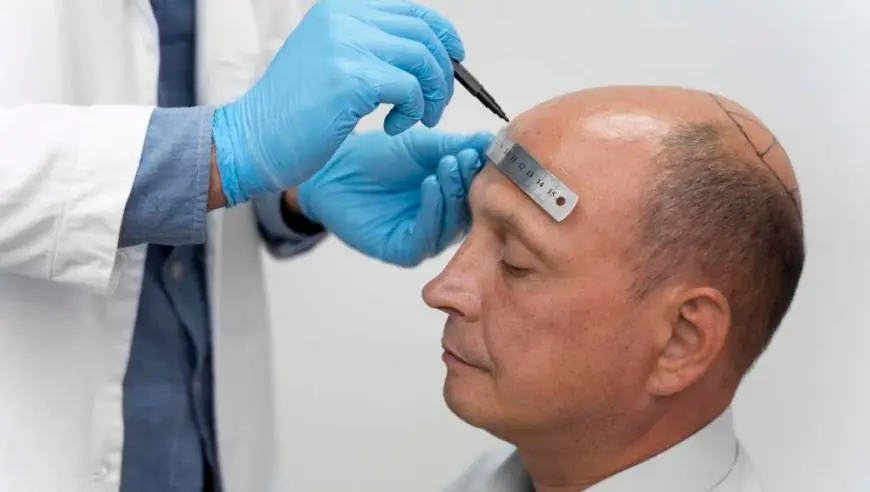What Kind of Hair Loss Can Be Treated for 1 Dirham?
Restore your hair with our exclusive 1 dirham transplant offer. Quality results at an unbeatable price—limited time only!

When exploring affordable hair restoration options, many are curious to know what kind of hair loss can be treated for 1 Dirham. With such an unbelievably low price, it's only natural to question whether the offer is suitable for all types of hair loss or only specific conditions. The answer lies in understanding how hair transplants work, what causes hair loss, and how compatible your condition is with this Hair transplant for 1 dirham in Dubai(زراعة الشعر مقابل 1 درهم في دبي)—even when it comes at an impressively discounted rate.
Understanding the Scope of Treatment:
Hair loss can occur due to numerous factors: genetics, hormonal changes, stress, illness, and even environmental conditions. The most commonly treatable form is androgenetic alopecia, more widely known as male or female pattern baldness. This is where a 1 Dirham hair transplant may offer a viable solution. Transplants work by harvesting healthy follicles from areas of dense growth and relocating them to thinning or bald areas. However, not all types of hair loss respond well to transplantation, especially those related to autoimmune conditions or scarring alopecia.
Types of Hair Loss Commonly Treated:
A 1 Dirham hair transplant is best suited for the following hair loss conditions:
-
Male Pattern Baldness (MPB): One of the most frequently treated forms, characterized by receding hairlines and thinning at the crown.
-
Female Pattern Hair Loss (FPHL): Typically involves a general thinning across the top of the scalp while preserving the frontal hairline.
-
Receding Hairlines: Where hair loss is mainly at the temples and front, suitable for restoration with targeted grafting.
-
Crown Baldness: Circular thinning at the back of the head, often addressed in transplant plans.
-
Traction Alopecia: Hair loss from tight hairstyles; if the follicles are still viable, transplant can fill in gaps.
It’s important to note that the success of treatment is not about the price tag—it’s about the suitability of the candidate and the underlying cause of the hair loss.
Risks and Considerations:
Even though a 1 Dirham hair transplant seems budget-friendly, it still carries the usual risks and post-treatment considerations. These include:
-
Shock Loss: Temporary shedding of existing hair near the transplant site.
-
Infection or Folliculitis: Risk is low with proper care, but hygiene is critical.
-
Uneven Hair Growth: Especially if the treated area is large and requires multiple sessions.
-
Scarring: Though minimal with modern techniques, small linear or dot-like scars can form in donor areas.
Patients must be thoroughly evaluated for their hair type, density, and scalp condition to minimize these risks and enhance treatment outcomes.
Benefits of Identifying the Right Hair Loss Type:
Choosing the correct type of hair loss to treat with a Hair transplant for 1 dirham treatment(علاج زراعة الشعر مقابل 1 درهم) brings several benefits:
-
Higher Success Rate: Treating the right candidates means better follicle survival and visible regrowth.
-
Natural Appearance: Proper alignment and placement ensure undetectable transplant work.
-
Boosted Confidence: With restored hairlines or filled-in bald patches, individuals regain a youthful look.
-
Minimally Invasive Results: Most transplants now use advanced tools that reduce downtime and discomfort.
When expectations align with medical feasibility, even a low-cost procedure can provide impactful, long-term results.
Frequently Asked Questions:
Can alopecia areata be treated with this offer?
Typically no. Alopecia areata is autoimmune-related and unpredictable, making transplant results less reliable.
Is female hair loss treatable with a 1 Dirham transplant?
Yes, in cases of pattern hair loss or thinning that is stable and not caused by hormonal shifts or medication.
Can someone with full baldness benefit?
Complete baldness may require more grafts than a single session allows, especially with limited donor hair. Results vary depending on extent.
How do I know if I’m a good candidate?
A proper consultation with scalp analysis, history, and follicle assessment determines eligibility.
Conclusion:
Understanding what kind of hair loss can be treated for 1 Dirham starts with evaluating your specific condition. While this offer makes hair transplants accessible to a broader audience, not all hair loss types are eligible or ideal for such a procedure. Male and female pattern baldness, receding hairlines, and localized thinning generally respond well. However, autoimmune, scarring, or diffuse unpatterned alopecia may not. Knowing the root cause of your hair loss is key. When matched properly with treatment, even a 1 Dirham hair transplant can deliver surprisingly rewarding and natural-looking results—without compromising quality or care.
What's Your Reaction?
 Like
0
Like
0
 Dislike
0
Dislike
0
 Love
0
Love
0
 Funny
0
Funny
0
 Angry
0
Angry
0
 Sad
0
Sad
0
 Wow
0
Wow
0















































